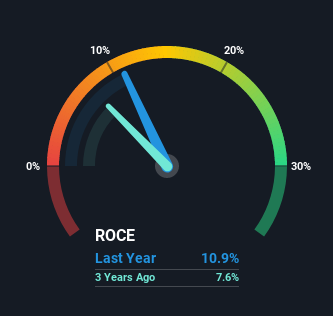Returns At TransUnion (NYSE:TRU) Are On The Way Up
If we want to find a stock that could multiply over the long term, what are the underlying trends we should look for? One common approach is to try and find a company with returns on capital employed (ROCE) that are increasing, in conjunction with a growing amount of capital employed. This shows us that it's a compounding machine, able to continually reinvest its earnings back into the business and generate higher returns. With that in mind, we've noticed some promising trends at TransUnion (NYSE:TRU) so let's look a bit deeper.
What is Return On Capital Employed (ROCE)?
Just to clarify if you're unsure, ROCE is a metric for evaluating how much pre-tax income (in percentage terms) a company earns on the capital invested in its business. Analysts use this formula to calculate it for TransUnion:
Return on Capital Employed = Earnings Before Interest and Tax (EBIT) ÷ (Total Assets - Current Liabilities)
0.11 = US$742m ÷ (US$7.5b - US$680m) (Based on the trailing twelve months to September 2021).
Thus, TransUnion has an ROCE of 11%. That's a pretty standard return and it's in line with the industry average of 11%.
See our latest analysis for TransUnion
In the above chart we have measured TransUnion's prior ROCE against its prior performance, but the future is arguably more important. If you're interested, you can view the analysts predictions in our free report on analyst forecasts for the company.
What Does the ROCE Trend For TransUnion Tell Us?
Investors would be pleased with what's happening at TransUnion. The numbers show that in the last five years, the returns generated on capital employed have grown considerably to 11%. The company is effectively making more money per dollar of capital used, and it's worth noting that the amount of capital has increased too, by 54%. So we're very much inspired by what we're seeing at TransUnion thanks to its ability to profitably reinvest capital.
The Key Takeaway
To sum it up, TransUnion has proven it can reinvest in the business and generate higher returns on that capital employed, which is terrific. And with the stock having performed exceptionally well over the last five years, these patterns are being accounted for by investors. With that being said, we still think the promising fundamentals mean the company deserves some further due diligence.
TransUnion does have some risks though, and we've spotted 1 warning sign for TransUnion that you might be interested in.
If you want to search for solid companies with great earnings, check out this free list of companies with good balance sheets and impressive returns on equity.
Have feedback on this article? Concerned about the content? Get in touch with us directly. Alternatively, email editorial-team (at) simplywallst.com.
This article by Simply Wall St is general in nature. We provide commentary based on historical data and analyst forecasts only using an unbiased methodology and our articles are not intended to be financial advice. It does not constitute a recommendation to buy or sell any stock, and does not take account of your objectives, or your financial situation. We aim to bring you long-term focused analysis driven by fundamental data. Note that our analysis may not factor in the latest price-sensitive company announcements or qualitative material. Simply Wall St has no position in any stocks mentioned.

